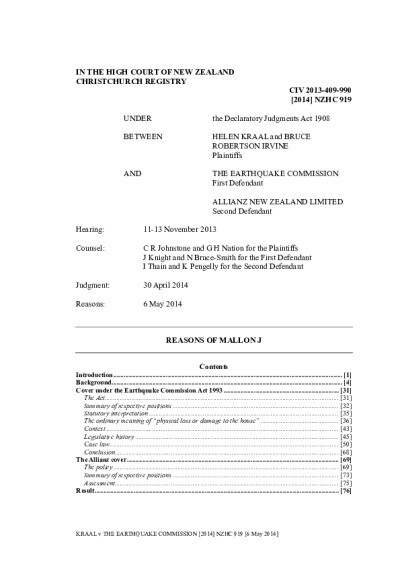
Date
Geographical Area
Pacific
Countries
New Zealand
Case Name
Kraal v Earthquake Commission
Case Reference
[2014] NZHC 919
Name of Court
High Court of New Zealand
Key Facts
Following the 7.1 magnitude earthquake which struck Canterbury on 4 September 2010, a devastating 6.3 magnitude aftershock struck close to the city of Christchurch on the 22 February 2011. This aftershock caused widespread damage to property and the deaths of 185 people, including five who died due to rockfall or cliff collapse.
The 2011 earthquake dislodged rocks and large boulders from areas in the Port Hills, including from the cliff face above Kraal’s home. As a result, the property was ‘red stickered’ by Civil Defence in the immediate aftermath of the earthquake, meaning that the property could not be entered and occupants were required to leave. In July 2011, the Christchurch City Council issued a s.124 notice against Kraal’s home, which warned people against entering it – under s.124 of the Building Act 2004 the Council has the power to issue a notice where it is satisfied that a building is dangerous, this includes where there is a risk of rockfall or cliff collapse. Kraal had not lived at the house since the s.124 notice.
This case concerned whether the homeowner’s loss of the right to occupy their home was covered by the Earthquake Commission (EQC) – a Crown entity which provides cover for disasters through a levy in home insurance policies. EQC provides cover up to a cap amount, after which the private insurer is responsible – and the homeowner’s insurance company if the damage cost is above the cap amount.
The 2011 earthquake dislodged rocks and large boulders from areas in the Port Hills, including from the cliff face above Kraal’s home. As a result, the property was ‘red stickered’ by Civil Defence in the immediate aftermath of the earthquake, meaning that the property could not be entered and occupants were required to leave. In July 2011, the Christchurch City Council issued a s.124 notice against Kraal’s home, which warned people against entering it – under s.124 of the Building Act 2004 the Council has the power to issue a notice where it is satisfied that a building is dangerous, this includes where there is a risk of rockfall or cliff collapse. Kraal had not lived at the house since the s.124 notice.
This case concerned whether the homeowner’s loss of the right to occupy their home was covered by the Earthquake Commission (EQC) – a Crown entity which provides cover for disasters through a levy in home insurance policies. EQC provides cover up to a cap amount, after which the private insurer is responsible – and the homeowner’s insurance company if the damage cost is above the cap amount.
Decision and Reasoning
The Court first considered the extent of EQC’s coverage, stating that it was limited to disaster damage, which, on examination of the provisions in the Earthquake Commission Act 1993, they determined to be physical loss or damage to a residential building which is either a direct result of the disaster, is imminent as a direct result of the disaster, or due to the measures taken to avoid the spread or to mitigate the consequences of a disaster.
Although the Court stated that the plaintiff had suffered a loss in terms of the use and enjoyment of the house, they did not agree that this constituted a physical loss to the property. This is because the deprivation of physical possession, which is a loss of one of the legal rights which constitute ownership, would be a loss ‘of’ or ‘in respect of’ the property, rather than a loss ‘to’ the property. Therefore, this deprivation did not constitute the physical loss required to be covered by EQC. Instead, to be covered by EQC, some type of physical damage had to occur to the property.
The Court also found that the deprivation of the use and enjoyment of the house did not constitute damage under the disaster cover in Kraal’s insurance policy.
Although the Court stated that the plaintiff had suffered a loss in terms of the use and enjoyment of the house, they did not agree that this constituted a physical loss to the property. This is because the deprivation of physical possession, which is a loss of one of the legal rights which constitute ownership, would be a loss ‘of’ or ‘in respect of’ the property, rather than a loss ‘to’ the property. Therefore, this deprivation did not constitute the physical loss required to be covered by EQC. Instead, to be covered by EQC, some type of physical damage had to occur to the property.
The Court also found that the deprivation of the use and enjoyment of the house did not constitute damage under the disaster cover in Kraal’s insurance policy.
Outcome
The Court declined to issue the declaration sought by the plaintiff.
Link
Disclaimer
This case law summary was developed as part of the Disaster Law Database (DISLAW) project, and is not an official record of the case.
Document
Document